Spring 2004 was an unusual time to be reviewing school lunches around Boston. The national debate about obesity and diet was reaching all the schools I visited, and most systems were already in some transition. The Boston School Committee, which oversees the city’s public schools, voted to phase out many junk foods—including fried snacks and sugared drinks in machines—shortly after my visits to two of their schools. An experimental scratch-cooking program devised by a parent volunteer in Brookline was adopted townwide the same week I tasted their meatballs. The head of the Bedford, Massachusetts, program had just returned from an obesity conference when we met for lunch at Bedford High. I began to think that school lunches as I remembered them from my own student days were becoming extinct.
In some ways, the school lunches I ate in the 1960s were already extinct. Many dessert items scratch-cooked at that time are now made in factories and sold from machines. It is now rare to see any solid piece of meat or fish, even “mystery meatloaf.” At least in eastern Massachusetts, gloopy gravy is out; spaghetti sauce is in. Steam-table green beans have been abandoned. However, the dismal side of school lunch really hasn’t changed, and it may never change. But that’s a policy prognostication—and I’m a food critic. By the standards of my profession, I can tell you, after visiting six schools for this assignment, that school lunch is still tasteless, undercooked, or overcooked. It’s still starchy and greasy, underseasoned and oversalted, short on fiber, and long on spaghetti. Kids still don’t like it and waste lots of it, and attempts to make it more home-like offend more kids than they reach. Government-provided cheese is now low in fat, but still tasteless. Peanut butter is less common, due to fear of nut allergies. Despite all the changes about what might constitute a healthful diet, kids still don’t want to eat foods that are good for them, and they do want to eat simple sugars and starches, saturated fats, and things they have eaten before. Multiculturalism has slightly lengthened the list of starchy, sugary foods kids will eat, but has not done much for diet diversity: almost every cafeteria I visited reported that pizza is the most popular meal and French fries are the most popular side dish. There are probably tacos and spring rolls out there, too.
So improvements will have to be measured against utilization. A reform is successful if it edges closer to the new dietary guidelines without reducing the number of lunches sold. Kids can always brown bag, and most of the brown bags I saw contained junk food. A few, however, contained ethnic food, including an Asian Indian lunch in three tiffins (the nesting tin cylinders used as lunchboxes in India), for which I would have traded all the lunchroom pizza in Boston, and which was happily consumed by the girl who brought it to school.
A Brief History of Scholastic Cuisine
Though I am primarily a food critic, I have written a book about the traditions of American cooking (which included a chapter on school lunches) and can tell you that hot lunches in public schools were originally produced, with a few exceptions, early in the 20th century by local charities because immigrant children were coming to school hungry. So school lunches have historical baggage. And there were always church-state complications. Public school lunches must be nonsectarian, which has historically meant accommodating religious preferences rather than ignoring them: having nonmeat alternatives on Fridays for Catholics, and, to a lesser extent, giving Jews—and now Muslims and Hindus—alternatives every day. Emma Smedley’s 1909 Philadelphia menus for the first William Penn School lunch program save fish and seafood for Fridays and offer peanut butter and egg sandwiches or dairy entrées most days. Nutritionally, school lunches were devised to be bland and filling, and were made up of discrete parts, unlike immigrant meals in which foods were mixed together. In addition, school lunches were supposed to Americanize a diverse population, and thus always had some degree of social as well as nutritional indoctrination intended.
The obesity issue fits well into some of the historical missions of school lunch such as social progress and uplift, less well into the original mission to feed the hungry. Even the current law—known as The School Lunch Act of 1946—was passed because too many young men were found to be too malnourished for the WWII draft. A modern conservative columnist, Kate O’Beirne, writing in the National Review, has questioned the value of food stamps, school breakfasts and lunches, and the WIC programs (Special Supplemental Nutrition Program for Women, Infants, and Children): “With rates of excess weight and obesity highest among low-income households, budget officials should be asking themselves why tens of billions of dollars are being spent each year by federal nutrition programs aimed at boosting food consumption by the poor.” Of course any nutritionist could tell O’Beirne how one could be overfed and undernourished at the same time, but it will be quite a lot harder to persuade school-lunch customers to reach for an orange instead of a sweetened soda.
A Political Smorgasbord
Another significant fact about school lunches today is the “free” and “reduced” lunch program. The federal government now subsidizes school lunches to the tune of almost $9.5 billion every year. (See “The School Lunch Lobby.”) The subsidy to each school varies depending on the number of students from families under an established income line (which is 130 percent of poverty). The per-meal rate for free lunches (currently, $2.24) can be higher than the actual cost, so there may be some advantage to schools with many poor students, although this improvement is usually offset by inefficiencies of older buildings with outdated kitchen equipment. Although the most popular lunch in every school I visited is pizza, it is hard to make good pizza without a professional pizza oven—so the kids get the stuff much like you’d find in the frozen food department of your local supermarket: prepackaged and filled with additives. Many older schools in Massachusetts that have professional ovens cannot use them, nor even their commercial stoves, because state law now requires a ventilation hood with a sprinkler system. For some reason, convection ovens, which blow hot air over the food, are exempt from these rules, but convection ovens just don’t bake pizza well.
In fact, the processed junk-food invasion of our schools was nearly complete before parents, principals, and school lunch directors realized what had happened. They are now trying to improve nutrition, reduce access to empty-calorie foods, and increase consumption of whole foods, fruits, and vegetables. But it’s not easy. (The new government food pyramid, unveiled in early 2005, is a large can of worms. It pleases almost no one and does less than most state and city school-lunch regulations are trying to do about sugar and fat.) One area of difficulty has been “à la carte” or supplementary foods—items that are sold at the lunchroom from machines or as extras. Boston’s 138 schools, not all of which have kitchens or lunchrooms, have 206 vending machines. Some students eat at their desks. (Eighty-eight Boston schools do not have gyms, either.) Many Boston schools do not have working water fountains, due to lead contamination, so removing drink machines is problematic.
When Boston city councilor John Tobin began a campaign against the vending machines, companies called him offering to sponsor exercise programs, or to turn off the machines in multi-use buildings during school hours, leaving them as glowing billboards. Texas has banned soda, gum, and candy from schools. But so far these are exceptions that prove the rule.
The most promising developments I saw came from two opposite directions: from food conglomerates reformulating snack foods to eliminate transfats, cut sugar, or add fiber; and from parent groups intervening to encourage whole foods and healthier recipes. I had selected for schools with good principals, but also noted some positive input from school-lunch directors and central authorities. The inertia is large, however, and beyond the habits of existing school-lunch systems is the classic problem of any school-based effort to reform the larger society—junk food that cannot be obtained in school can be brought from home or purchased nearby.

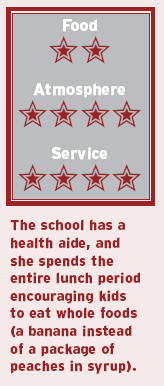
Although it is a successful and popular citywide school with a long waiting list, most of its students come from the inner city of Boston. Almost two-thirds are Hispanic, and almost everyone qualifies for a free or subsidized lunch, and has a barcode card to present to the cashier. The Hernandez (yes, that’s what it’s called) is a “two-way bilingual” school, offering instruction in both English and a second language, and while bilingual education has been politicized in Massachusetts and elsewhere as a leftist deviation, in many ways the Hernandez is a Hispanic institution, and thus a conservative one. The parents’ council is considering school uniforms. Test scores are taken seriously, and Hernandez pupils exceed the citywide averages.
I’m here on Friday, pizza day, the most popular lunch of the week (as it proves to be at every other school I visit). Children are brought to the basement cafeteria by their teachers. I have pizza, milk, and a package of peaches in syrup. The pizza is made in a convection oven, and it has a bready, thick crust that doesn’t seem fully baked, not much tomato sauce, and not a lot of cheese. This isn’t very good pizza, and the kids know it, even though it is their favorite lunch. One of the 6th-grade classes has won the right to either a pizza party or an ice cream party, because more of their parents attended parents’ night than the parents of any other class. So on Friday, pizza day, they pick the pizza party, not the ice cream party, and an aide goes to the office for enough petty cash to send out for commercial pizza—none of that cafeteria stuff—and 7-Up. (This year, The Hernandez cafeteria has switched to a stuffed pizza on Fridays.)
The Hernandez is chained to Boston’s central kitchen for purchasing and budgeting, although it has enough kitchen equipment to deviate from the menu plan. (Schools without kitchens have no choice and must serve central kitchen–prepared meals.) Each Boston school cafeteria has to balance a budget, which makes for some interesting choices at Hernandez (and many other Boston public schools). One choice that was going off the table when I had my Hernandez pizza was using vending machines and side sales of ice cream to generate the cash for off-menu rice and beans, say. Within that overwhelming constraint, many other things are done well. The school has a health aide, and she spends the entire lunch period encouraging kids to eat whole foods (a banana instead of my peaches, for example). The cafeteria manager is a young Hispanic male, an extroverted fellow who knows many of the students by name. The manager has ordered baked chips to sell alongside the fried ones; such à la carte or adjunct foods are the largest problem in school nutrition. The kids seek out the fried chips. The Hernandez has no machines but sells chips, ice cream, and fruit drinks. These sales are part of the cafeteria’s budget in many Boston schools.
In the cafeteria there were some nutrition posters, and The Hernandez had the most recycling bins for both foam-plastic trays and drink containers of any school I visited. Kids from kindergarten to 8th grade clean up after themselves. As I looked around the room, I didn’t see that many fat kids, but the ones who have put on a lot of weight are more frequent in the upper grades.

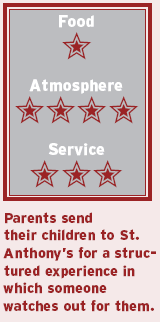

St. Anthony’s is a parish school in Boston’s working-class Allston neighborhood. Like many inner-city Catholic schools, it has become an alternative for black and Hispanic families as well as white ethnics. It has an extended-day program that is very useful for working families. St. Anthony’s currently has a large number of Brazilian-American students. It is not rich in resources, and because it lacked a legal ventilation hood, the school had given up serving hot lunch until a few years ago, when principal Gary Phillips found a small catering company servicing similar Catholic schools north of the city. All the food is precooked and reheated in a pair of convection ovens, and the pizza is limp. It comes with a fruit cup. It does have somewhat more tomato sauce than most school pizza, so it has a little more flavor. It is still the students’ favorite meal. They also like chicken nuggets, served with pickles and potato chips; tacos, hamburgers, and chicken patties; and as a treat they recently had French toast. Vegetables, garden salad, baked chicken, and green beans have been harder to sell. Real mashed potatoes and “egg McMuffins” have been popular treats. Phillips also reports efforts to serve rice and beans, but students spurned them for the same reason The Hernandez kids did: they were not like their mothers’ rice and beans.
The lunch is entirely comparable to public school lunches in Boston, but costs a little more, about $2.75 a day on an annual basis. Parents pay for lunch at the beginning of the year, so kids don’t have to bring money to school.
The basement cafeteria is loud and old, but very clean. There is a juice machine with water in it, and a Coke machine, which is going over to milk drinks soon.
Parents send their children to St. Anthony’s for a structured experience in which someone watches out for them. In the lunchroom, that someone is Mr. Phillips, who leads a quick prayer before children eat and excuses them for some outdoor play at the end of lunch. (Many also eat breakfast at the school.) In between he shushes them when things get too loud and holds talkers in for a few minutes.
The children wear uniforms. Children clean up after lunch on a rotating basis, having to do the job only about twice each year. They wash the tables, put up the chairs, and sweep. Recycle bins are prominent. The only food poster is one promoting good nutrition; more typical is a reading poster with Jackie Robinson on it.

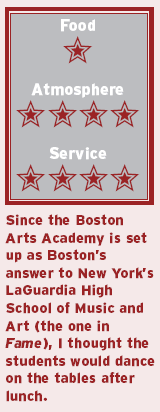
Since the Boston Arts Academy is a pilot high school (a charter-like public school, but with unions) set up as Boston’s answer to New York’s LaGuardia High School of Music and Art (the one in Fame), I thought the students would dance on the tables after lunch. Nope. In fact, the three upper classes have the option to leave school for lunch, and many do grab something from the fast-food outlets near Fenway Park (about a hundred yards away). I’m also surprised that the cafeteria doesn’t have an art exhibit up, although an installation of objects embedded in translucent rubber sculptures was in preparation. That said, it’s a great place to eat a mediocre lunch, because the students are so neat.
About 20 percent of the students are diet-conscious dancers, so there is some interest in nutrition here. My lunch companions were theatre guys, however, and freshmen, so they had to eat in school. One chose pizza, fairly limp, underdone, and starchy, despite the presence of real ovens. Israel had it down to a science with the chicken patty, French fries, and cheese sauce. He carefully arranged it all in the bun, “for extra flavor in every bite.” I had a fairly poor, well-done double cheeseburger, and a packaged fruit cocktail. I could have had a grilled cheese sandwich on white bread, onion rings, a pasta dish, or an apple or orange. À la carte foods include the usual ice creams and a snack machine, and frequently student groups have bake sales.
Graduating senior Andrea Adams, who sees a career in arts management, has worked with the cafeteria to provide more nutritious sandwiches, salads (on Thursdays), fruit and cheese (on Wednesdays) for an afterschool snack bar she runs. This is an important resource, because a majority of students stay after school on any given day to work on portfolio arts projects while taking a full academic schedule. Andrea also raffles off baskets of food and other goodies and obtained a meeting with one of the snack-machine companies. After her meeting, juice and milk drinks replaced sodas in one of the machines.
Although the Boston Arts Academy shares the cafeteria with another high-school program, both emphasize community, and students are asked to clean up after themselves and sometimes after others. The result is an almost unlittered cafeteria, even after several lunch periods.
Of course, there are colorless sugared drinks, and some of the milk drinks have as many as 460 calories (Nesquik double chocolate). A popular brand of 100 percent orange juice has 58 grams of sugar in an 11.5-ounce can.

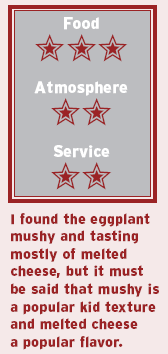
Bedford is a high-tech suburb north of Boston, population 12,400. A nearby Air Force base leavens the school population with 28 percent military kids. I had heard about a progressive program there from nutritional consultant Antonia Demas. (The elementary school lunches here have made the national top-10 list of Nick Jr. magazine.) The obvious signs of progress are choices, especially a hot vegetarian lunch every day. Lunch director Rob Clickstein has worked to get whole fruit on the line: a sandwich option with breads including wholegrain; and a choice of tuna salad, egg salad, pastrami, ham, roast beef, or seafood salad. Of course, kids don’t eat the sandwiches, perhaps because you have to make them yourself from the bread and a scoop of filling. I had some eggplant Parmesan, some very decent garlic bread, a predressed salad, and a slice of watermelon. I found the eggplant mushy and tasting mostly of melted cheese, but it must be said that mushy is a popular kid texture and melted cheese a popular flavor. Around me, most of the students had meat ravioli without the salad, although they did like the watermelon slices.
Although Bedford has almost no one on free or subsidized lunch, the price was kept to $1.50 (this year raised to $2). That leaves some change for the machines and à la carte ice cream, and Clickstein has insisted on baked chips, NutriGrain fruit bars, yogurt, pretzels, Nature Valley trail-mix bars, caramel corn rice cakes, reduced-fat Cheezits, and Dole fruit ‘n’ juice bars in the ice cream freezer. But these less-deadly vending machine snacks were still competing with Twix bars, Ritz snacks, and real Cheetos. There is a fad for Glacier “Vitamin Water.” It’s a fair fight: there are no advertising posters, and no nutritional posters.
Bedford High has some interesting eating customs that go back a few decades. Seniors have their own dining room and their own cafeteria line. All students have a 10 a.m. break for bagels, muffins, cookies, and pretzels. Students don’t recycle their cans, foam plates, or plastic flatware. The only student who cleans up is a boy who has a job in the kitchen. Some litter stays on the floor between lunches. It’s the suburbs.


Lunch at the Runkle School began to change in February 2004. Parent Vince Connelly, a chef and cookbook author, volunteered to cook for two months, using whole foods, more seasoning, and the latest nutritional guidelines. He also kept it simple, since the school has only two gas burners and a convection oven. He turned everything back over to the staff during a two-week phase-out. The Parent Teacher Organization invested $600, mostly for pots and pans, since the kitchen had been mostly reheating prepared foods, The program was so successful that increased sales allowed the hiring of more staff, making it sustainable after Connolly stopped cooking. The principal backed the program, and students made posters, now up in the cafeteria, about healthier eating. “Be healthy instead of being pretty.” “If these healthy creatures eat them [picture of horses eating vegetables], why don’t you?” “What does Popeye eat?” I reviewed a meal after the phase-out, and Connelly warned me that there had been some backsliding on the garlic.
The most interesting thing on my plate was pasta (penne rigate) and meatballs, since the meatballs were made from actual meat, and fortified with tofu, real flat-leaf parsley, garlic, onions, and quite a lot of Romano cheese. They were somewhat lean, but very tasty and well seasoned, and kids were eating theirs all over the room. If we must have beef, at least let it taste like beef. I didn’t see kids eating the whole-wheat roll I had, but we all had a small cup of orange juice instead of the usual milk, and there was some interest in the steam-table corn. Desserts included a fresh fruit salad of watermelon, strawberries, and peaches. Some other recipes include chicken fingers made from actual chicken and baked with a cornmeal crust for extra crunch, lentil soup (!), sweet potato fries, cheeseburger subs, barbecue chicken, vegetarian burritos, and potato-broccoli-cheddar soup. The Pepsi machine now has only water and 100 percent orange juice, and the snack machine has baked chips and juice drinks in small sizes with only 60 calories.
Although Brookline is Boston’s closest suburb, surrounded by Boston on three sides, less than 10 percent of Runkle’s students qualify for free or subsidized lunch. Again, the lesson of recycling is not being taught despite the use of plastic foam trays.
Not every student at Runkle was eating an ideal diet, but the school’s cafeteria lights a way toward marketing school food that is both more healthful and more palatable, using existing resources, whole foods, and trading increased labor costs for higher sales and lower food costs. It’s amazing what you can do with a few heads of garlic.
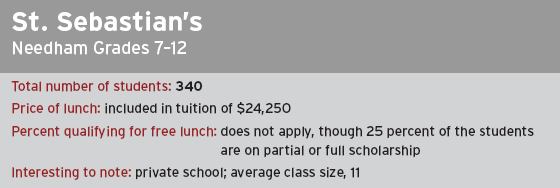
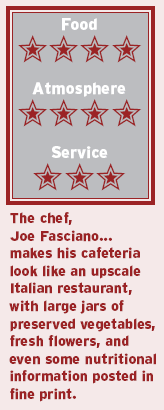
St. Seb’s, a pricey private Catholic boys school, is really the ringer in this group. Because the parents pay tuition comparable to other private day schools, $24,250, the lunch is subsidized at levels to which public and more urban Catholic schools cannot aspire. The school has contracted with a catering company, Sage Dining, which provides an on-site chef. The chef, Joe Fasciano, has a restaurant background, and makes his cafeteria look like an upscale Italian restaurant, with large jars of preserved vegetables, fresh flowers, and even some nutritional information posted in fine print. About once a month there is a special meal with stations where the boys can order a stir-fry, an omelet, or a pasta dish as they want it.
The basic lunch on the day I visited was pulled pork barbecue on a bun with corn on the cob and spicy French fries that were actually fried, and therefore actually crisp. There was a 15-item salad bar, including dried apricots and macaroni salad as well as the usual greens, vegetables, and condiments. There were home-baked multigrain rolls, chicken vegetable soup (bland but not oversalted), and a deli bar with tuna, corned beef, salami, and turkey. There were a lot of dessert choices: two kinds of cake, Jell-O, vanilla pudding, soft-serve ice cream, Popsicles, apples, and oranges. (The vanilla pudding was the only dessert at any school that reminded me of my own school lunches.)
Of course, the boys I saw at lunch were having almost none of this. Most had the pulled pork and the fries. The salad bar was used almost exclusively by faculty, but at least it was there. The boys took their own drinks from machines: milk, water, sports drinks, or fruit juices. There were machines for iced tea and coffee, which the boys know is off-limits to students. One interesting thing Fasciano told me is that the boys had developed a taste for mild hot sauce, and I saw bottles going around.
The all-boys atmosphere is, at least with Catholic supervision, less loud than mixed-gender lunches at the other schools I visited. Boys bus their own trays. There doesn’t seem to be any recycling, but of course there aren’t a lot of disposable items in use here. St. Seb’s doesn’t prove that kids will eat health-food, but it does suggest that they will eat foods with spices and herbs if they are well presented. As elsewhere, Italian food is mainstream, with stuffed shells a popular lunch, and pizza in heavy rotation during Lent.
Mark Zanger is a food reporter for the Boston Phoenix, where he writes under the pen name Robert Nadeau. He is the author of The American History Cookbook, Greenwood Press, 2003.


